What To See
Büyükada - Luna Park Meydanı
- Details
- Created on 05 April 2013
- Last Updated on 11 April 2013
The Monastery of St. Nicholas
 The monastery of St. Nicholas (Hagios Nikolaos) is on the eastern shore of the island, accessible by both the shore road and another road leading from the meydan below the summit of Yüce Tepe. The monastery is on or near the site of the Byzantine settlement of Karyes, which was abandoned in the seventeenth century after being devastated in a fire. The earliest mention of the monastery is by the English traveller Thomas Smith in 1680. The original katholikon of the monastery may have been built on and from the ruins of the parish church of Karyes. In 1783 the monastery temporarily housed a "School for Greek Classes," which subsequently was relocated near the Patriarchate in Istanbul as the Megale Scole, or Great School, which is still in existence.
The monastery of St. Nicholas (Hagios Nikolaos) is on the eastern shore of the island, accessible by both the shore road and another road leading from the meydan below the summit of Yüce Tepe. The monastery is on or near the site of the Byzantine settlement of Karyes, which was abandoned in the seventeenth century after being devastated in a fire. The earliest mention of the monastery is by the English traveller Thomas Smith in 1680. The original katholikon of the monastery may have been built on and from the ruins of the parish church of Karyes. In 1783 the monastery temporarily housed a "School for Greek Classes," which subsequently was relocated near the Patriarchate in Istanbul as the Megale Scole, or Great School, which is still in existence.
When the Greek War of Independence began in 1821 the monastery was taken over by the Turkish Army. Later it was restored and served to accommodate Greek families from Istanbul on visits to Prinkipo. A fire in 1852 destroyed the interior of the katholikon, including the iconostasis and most of the icons. The church was rebuilt in 1860 according to the original design, a domed four-columned cross-in-square, the plan of virtually all Constantinople churches of the medieval Byzantine era. The supposition is that the original katholikon preserved the plan of the parish church of Karyes, which is believed to have dated from the Byzantine period. The attractive narthex, covered with a tiled roof, dates to 1873. Over the entrance there is a marble relief of a double-headed eagle, emblem of the Palaeologus dynasty, who ruled Byzantium during its last two centuries. On the exterior at the northwest corner there is an ancient Greek relief representing a chariot race.
Büyükada - Important Villas and Mansion Houses You Can Encounter During Short Tour And Grand Tour Which You Can Do With A Coach Or Bicycle
- Details
- Created on 05 April 2013
- Last Updated on 11 April 2013
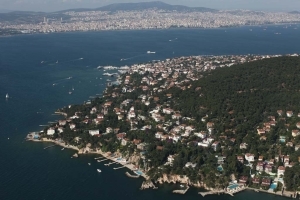 The street on the left side of the square leads to Fayton Meydanı, where all the horse-drawn carriages wait to be hired. The standard routes for visitors are the Büyük Tür (Grand Tour), a complete circuit of Büyükada, and the Küçük Tür (Short Tour), which does only the northern half, cutting across the waist of the island between Isa Tepesi and Yüce Tepe.
The street on the left side of the square leads to Fayton Meydanı, where all the horse-drawn carriages wait to be hired. The standard routes for visitors are the Büyük Tür (Grand Tour), a complete circuit of Büyükada, and the Küçük Tür (Short Tour), which does only the northern half, cutting across the waist of the island between Isa Tepesi and Yüce Tepe.
Büyükada - Two Monasteries on Two Hills
- Details
- Created on 05 April 2013
- Last Updated on 12 July 2016
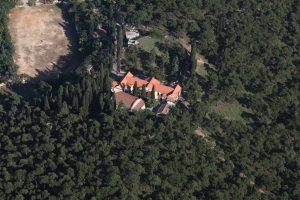 There are monasteries on both of the island’s hilltops, and there is a third on the eastern shore below Yüce Tepe, the southern peak. All three monasteries are accessible from the meydan at the waist of the island, to which one can take a fayton from the village.
There are monasteries on both of the island’s hilltops, and there is a third on the eastern shore below Yüce Tepe, the southern peak. All three monasteries are accessible from the meydan at the waist of the island, to which one can take a fayton from the village.
Isa Tepesi, the northern peak, is crowned with the monastery of the Transfiguration (Hagios Sotiros Christou). On the way up to the monastery one passes a huge wooden structure that once served as the Greek Orphanage, now abandoned and falling into ruins.
The monastery of St. George Koudonas crowns Yüce Tepe, the southernmost of the island’s two hills. A path leads up to the monastery from the meydan at the waist of the island.
The Monastery of the Transfiguration
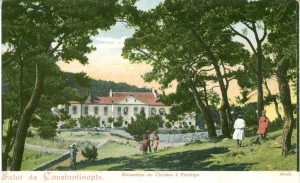 According to tradition, the monastery was founded in the Byzantine era, and implicit reference to it seems to have been made in a chrysobull issued in 1158 by the emperor Manuel I Comnenus.
According to tradition, the monastery was founded in the Byzantine era, and implicit reference to it seems to have been made in a chrysobull issued in 1158 by the emperor Manuel I Comnenus.
The monastery fell on hard times later in the Ottoman period, but it withstood these difficulties through the support of the guild of the Greek linseed oil merchants in Istanbul and an endowment from the Feneriote nobleman Pascharnikos Christodoulos Vlachoutsis. Patriarch Gregory V lived there in 1809; the former patriarch Chrysanthos moved to the monastery when he retired in 1826 and died there eight years later. Patriarch Sophronius was in residence during the years 1866-70, and through his efforts the monastery was restored and the present katholikon completed in 1869, in accordance with plans drawn by the architect Vasilis Dimitriou.
What remains of the monastery are its katholikon and an adjacent two-storey wing on its south, as well as some out-buildings on the western part of its grounds. The katholikon preserves the carved wooden iconostasis from the earlier church, gilded and decorated with floral and plant designs in both low and high relief. The doors of the Oraia Pylai are particularly notable, with eight small icons in their panels, the most remarkable being a depiction of the Annunciation, all dating from the eighteenth century. There is also a fine eighteenth-century Offertory Diptych, with Christ in the traditional Deesis representation atop the panels, flanked by the Virgin and St. John the Baptist. Set into the south exterior wall there is a replica of an ancient Greek funerary relief, dating from the second half of the nineteenth century.
The Greek Orphanage
 It is Europe’s largest wooden building, and the second largest in the world, according to Jak Deleon. The building was erected in 1898 by a French company, who planned to open it as a grand hotel called the Prinkipo Palas, with a gambling casino on the style of Monte Carlo. But Sultan Abdül Hamit II refused to give permission for such an establishment and it never opened. The building was then purchased by Eleni Zarifi, widow of the banker Leonidas Zarifi, who donated it to the Ecumenical Patriarchate on condition that it be used as an orphanage. The Greek Orphanage, which had been at Balıklı in Istanbul, reopened here in 1903, helped by a gift of 146 gold pieces donated by Abdül Hamit II, who also gave it tax-exempt status. The orphanage closed in 1964 and has since fallen into ruins, though it is still a most impressive site, one of the principal landmarks of Büyükada as seen from the sea.
It is Europe’s largest wooden building, and the second largest in the world, according to Jak Deleon. The building was erected in 1898 by a French company, who planned to open it as a grand hotel called the Prinkipo Palas, with a gambling casino on the style of Monte Carlo. But Sultan Abdül Hamit II refused to give permission for such an establishment and it never opened. The building was then purchased by Eleni Zarifi, widow of the banker Leonidas Zarifi, who donated it to the Ecumenical Patriarchate on condition that it be used as an orphanage. The Greek Orphanage, which had been at Balıklı in Istanbul, reopened here in 1903, helped by a gift of 146 gold pieces donated by Abdül Hamit II, who also gave it tax-exempt status. The orphanage closed in 1964 and has since fallen into ruins, though it is still a most impressive site, one of the principal landmarks of Büyükada as seen from the sea.
The Monastery of St. George Koudonas
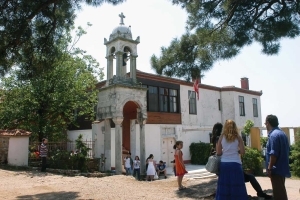 The monastery of St. George Koudonas crowns Yüce Tepe, the southernmost of the island’s two hills. A path leads up to the monastery from the meydan at the waist of the island.
The monastery of St. George Koudonas crowns Yüce Tepe, the southernmost of the island’s two hills. A path leads up to the monastery from the meydan at the waist of the island.
According to tradition, the monastery was founded in 963, during the reign of Nicephorus II Phocas (r. 963-9). The earliest reference to it is in the chrysobull of 1158 by Manuel I Comnenus mentioned earlier. The name Koudonas, which in Greek means "of the bells," comes from the story that a shepherd was grazing his flock on this hill when he heard the sound of bells coming from beneath the ground; when he dug down he found an icon of St. George, which he and other locals enshrined on the spot. This story is traditionally dated to the year 1625, and it probably represents the refounding of the monastery rather than a new foundation. Legend aside, the first abbot of record, Isaias, started building the present katholikon in 1752 and completed the main church of the Blachernitissa seven years later, also adding a number of monastic cells. Several additions were made in the following half century by the abbots Anthemios and Arsenios. Meanwhile a number of miracles were attributed to the icon of St. George, which was especially effective in curing mental ailments and in exorcizing those "driven by unclean spirits."
The present complex consists of six separate churches and chapels on three different levels, the older sanctuaries being on the lower levels. On the ground floor are the abbot’s house and the main church of St. George, both built early in the twentieth century. On the southern interior wall of the church is the original icon of Hagios Georgios Koudonas, now clad in silver. On a corner of the icon is a much later inscription, a moving appeal by a young Greek woman, who writes, "Dear St. George, help me go to Athens and study pharmacology."
A flight of steps leads to the first level below. Just beside the steps is a chapel of the Virgin Blachernitissa. Beyond that is another chapel of St. George, where iron rings set into the wall indicate that this was the place where mental patients were confined in the hope that they would be cured by the wonder-working icon of Hagios Georgios Koudonas. The room at the bottom of the stairs is a tiny shrine with an hagiasma, supposedly the place where the sacred icon of St. George was excavated. Beyond that is another chapel, dedicated to the Holy Apostles.
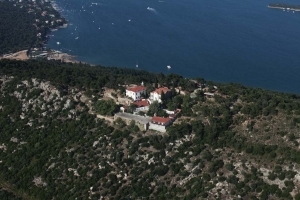 The feast day of St. George is celebrated on 23 April when thousands of pilgrims from around the world—including Muslim Turks and other non-Christians—make their way to the monastery, many of them walking barefoot up the hill to attend the dawn service. After the service many of the pilgrims have lunch at the little outdoor restaurant on the hilltop, celebrating the day that traditionally marks the beginning of spring according to the old calendar. The restaurant serves simple meals and snacks, as well as its own unlabled red wine. The hilltop is embowered in pines, cypresses, and other trees in a setting reminiscent of the Greek isles, particularly when the bells of the monastery are ringing in this ancient shrine.The feast day of St. George is celebrated on 23 April when thousands of pilgrims from around the world—including Muslim Turks and other non-Christians—make their way to the monastery, many of them walking barefoot up the hill to attend the dawn service. After the service many of the pilgrims have lunch at the little outdoor restaurant on the hilltop, celebrating the day that traditionally marks the beginning of spring according to the old calendar. The restaurant serves simple meals and snacks, as well as its own unlabled red wine. The hilltop is embowered in pines, cypresses, and other trees in a setting reminiscent of the Greek isles, particularly when the bells of the monastery are ringing in this ancient shrine.
The feast day of St. George is celebrated on 23 April when thousands of pilgrims from around the world—including Muslim Turks and other non-Christians—make their way to the monastery, many of them walking barefoot up the hill to attend the dawn service. After the service many of the pilgrims have lunch at the little outdoor restaurant on the hilltop, celebrating the day that traditionally marks the beginning of spring according to the old calendar. The restaurant serves simple meals and snacks, as well as its own unlabled red wine. The hilltop is embowered in pines, cypresses, and other trees in a setting reminiscent of the Greek isles, particularly when the bells of the monastery are ringing in this ancient shrine.The feast day of St. George is celebrated on 23 April when thousands of pilgrims from around the world—including Muslim Turks and other non-Christians—make their way to the monastery, many of them walking barefoot up the hill to attend the dawn service. After the service many of the pilgrims have lunch at the little outdoor restaurant on the hilltop, celebrating the day that traditionally marks the beginning of spring according to the old calendar. The restaurant serves simple meals and snacks, as well as its own unlabled red wine. The hilltop is embowered in pines, cypresses, and other trees in a setting reminiscent of the Greek isles, particularly when the bells of the monastery are ringing in this ancient shrine.
The view from the summit of Yüce Tepe is superb, encompassing all of the Princes’ Isles and the Asian shore of the Sea of Marmara, a prospect duly praised by Grosvenor, although the villages that he mentions have now all been amalgamated into the urban sprawl of Istanbul:
The view from this peak is the most extensive which Constantinople affords. From the height of six hundred and seventy feet the eye sweeps over the sea and comprehends the eastern shores of the Marmora. Northwest, beyond the island group, the fairy outline of Stamboul and Kadikeui fringes the sky, while the sombre point of Phanaraki advances in the foreground. North and east along the sinuous Asian coast, village presses upon village, each enriching the landscape with the tints of natural beauty or association.
Büyükada - Center
- Details
- Created on 18 February 2013
- Last Updated on 11 April 2013
The Ferry İskele
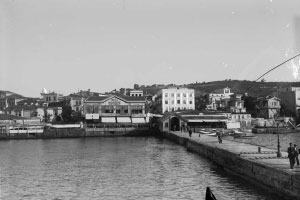 The lead-domed terminal building of the regular ferry, distinguished by its octagonal passenger hall, was designed in 1899 by the architect Mihran Azaryan of Izmit and completed in 1915. The tile revetment was made by Mehmet Emin Efendi of Kütahya. The upper floor was used as a cafe in the years 1918-23; from 1923-50 it was the District Office of the Republican Party’s Adalar (Islands) branch; in 1950-51 it housed the island’s first indoor cinema. The building was restored in 1999-2000, when Çelik Gülersoy of the Turkish Touring and Automobile Club created an elegant cafe on the upper floor, with a large balcony commanding a view of the Asian shore of the Marmara, an ideal spot to take refreshments before or after touring the island.
The lead-domed terminal building of the regular ferry, distinguished by its octagonal passenger hall, was designed in 1899 by the architect Mihran Azaryan of Izmit and completed in 1915. The tile revetment was made by Mehmet Emin Efendi of Kütahya. The upper floor was used as a cafe in the years 1918-23; from 1923-50 it was the District Office of the Republican Party’s Adalar (Islands) branch; in 1950-51 it housed the island’s first indoor cinema. The building was restored in 1999-2000, when Çelik Gülersoy of the Turkish Touring and Automobile Club created an elegant cafe on the upper floor, with a large balcony commanding a view of the Asian shore of the Marmara, an ideal spot to take refreshments before or after touring the island.
Heybeliada - Tour Trough the Woods, Monasteries and Çam Limanı
- Details
- Created on 11 April 2013
- Last Updated on 11 April 2013
Monastery of Hagia Triada
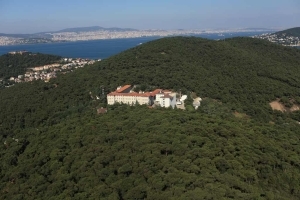 In Byzantine times, there were at least three monasteries on Heybeliada, then known as Halki. The most renowned of these was Hagia Triada, the Holy Trinity, whose site on Ümit Tepesi is occupied by the Greek Orthodox theological school of the same name, a direct descendant of the original Byzantine monastery. The present monastery is the most prominent monument on Heybeliada, dominating the view from an approaching ferry and from within the village itself.
In Byzantine times, there were at least three monasteries on Heybeliada, then known as Halki. The most renowned of these was Hagia Triada, the Holy Trinity, whose site on Ümit Tepesi is occupied by the Greek Orthodox theological school of the same name, a direct descendant of the original Byzantine monastery. The present monastery is the most prominent monument on Heybeliada, dominating the view from an approaching ferry and from within the village itself.
The earliest reference to a monastery on Halki is in the writings of St. Theodore of Studius early in the ninth century. Theodore, abbot of Constantinople’s famous monastery of St. John of Studius, was exiled to a monastery on Halki by Leo V (r. 813-20) because of his criticism of the emperor’s iconoclastic policy. While on Halki, Theodore wrote a number of letters, theological treatises, and poems, one of which was addressed fondly to the monastic cell in which he was confined.
The monastery of the Holy Trinity was restored by the patriarch Photius I (r. 858-67, 877-86), who was twice exiled there, first between his two terms as patriarch and then in the years 887-90. Photius died in the monastery in 890 and was buried there; he was subsequently canonized and is today revered as the patron saint of the Theological School of the Holy Trinity.
The monastery was apparently destroyed at the time of the Turkish Conquest in 1453, moving one anonymous chronicler to lament the loss of what "had earlier been a place where wisdom and knowledge were studied, not only by monks but also by kings and noblemen." In 1550 the monastery was rebuilt or at least partially restored by the future patriarch Metrophanes III (r. 1565-72, 1579-80). Metrophanes also gave to the monastery some three hundred manuscripts, a priceless gift that formed the nucleus of what was to become one of the most renowned libraries in the Orthodox world after that of the Patriarchate in Istanbul.
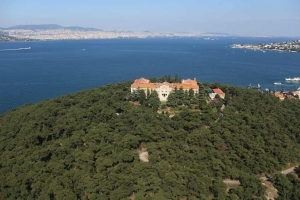 Hagia Triada went through difficult times in the seventeenth and eighteenth centuries, but its finances, at least, improved after Peter the Great, Tsar of Russia (r. 1682-1725), issued a chrysobull giving the monastery a long-term endowment. The monastery was rebuilt and refurbished in 1773 through the efforts of its energetic abbot, Samuel the Deaf. The monastery was badly damaged in 1821, at the beginning of the Greek War of Independence, when it was attacked by a mob and set on fire. The monastery was rebuilt in 1844 by Patriarch Germanos IV, who decreed in a synod that "a theological school should be built for a purpose pleasing to God and dwelt in by theology teachers, priests who wish to learn, and future priests." Wooden buildings were erected to house the classrooms, study hall, teachers’ quarters, student dormitories, refectory, infirmary, and patriarchal apartments, while a two-storey stone structure was built for the library. Then in 1891 a three-storey wing was added to house the administrative offices and new dormitories. All of these structures were seriously damaged in the great earthquake of 1894. Thus a completely new building had to be erected for the monastery, all of the funds for which were provided by the philanthropist Pavlos Skylitsis Stephanovik. The new monastery was designed by the architect Pericles Photiades, and the building was officially dedicated on 6 October 1896, the archimandrite Germanos Gregoras presiding as Rector of the Theological School.
Hagia Triada went through difficult times in the seventeenth and eighteenth centuries, but its finances, at least, improved after Peter the Great, Tsar of Russia (r. 1682-1725), issued a chrysobull giving the monastery a long-term endowment. The monastery was rebuilt and refurbished in 1773 through the efforts of its energetic abbot, Samuel the Deaf. The monastery was badly damaged in 1821, at the beginning of the Greek War of Independence, when it was attacked by a mob and set on fire. The monastery was rebuilt in 1844 by Patriarch Germanos IV, who decreed in a synod that "a theological school should be built for a purpose pleasing to God and dwelt in by theology teachers, priests who wish to learn, and future priests." Wooden buildings were erected to house the classrooms, study hall, teachers’ quarters, student dormitories, refectory, infirmary, and patriarchal apartments, while a two-storey stone structure was built for the library. Then in 1891 a three-storey wing was added to house the administrative offices and new dormitories. All of these structures were seriously damaged in the great earthquake of 1894. Thus a completely new building had to be erected for the monastery, all of the funds for which were provided by the philanthropist Pavlos Skylitsis Stephanovik. The new monastery was designed by the architect Pericles Photiades, and the building was officially dedicated on 6 October 1896, the archimandrite Germanos Gregoras presiding as Rector of the Theological School.
Read more: Heybeliada - Tour Trough the Woods, Monasteries and Çam Limanı
Heybeliada - Center
- Details
- Created on 18 February 2013
- Last Updated on 11 April 2013
Village Center
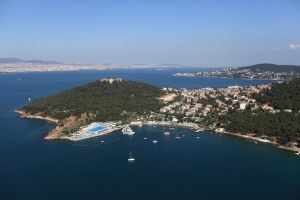 As the visitor approaches the island by ferry he can observe the Greek Orthodox seminary dominating its hill, the Halki Palas Hotel, the former Greek Commercial School (now part of the Naval High School), and the old windmill topping Değirmen Tepesi, above the Water Sports Club.
As the visitor approaches the island by ferry he can observe the Greek Orthodox seminary dominating its hill, the Halki Palas Hotel, the former Greek Commercial School (now part of the Naval High School), and the old windmill topping Değirmen Tepesi, above the Water Sports Club.
The focal point of the village is the ferry landing on the east coast, with the iskele for the sea bus a short distance to its north. The shore road betwen the two iskeles is lined with cafes and restaurants. The principal market street runs parallel to the shore road one short block in from the sea. On the southeastern promontory of the island, next to the ferry landing, is the Deniz Lisesi or Naval High School, with its twin-towered main building and miniature port, and just north of the iskeles is a little fishing port, in which fishing boats and pleasure craft are anchored.
The Greek Orthodox Church of St. Nicholas
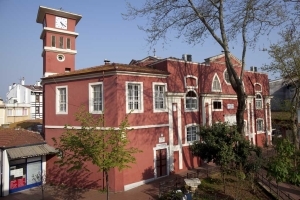 The Greek Orthodox church of St. Nicholas (Hagios Nikolaos) dominates the main square of the village, two short blocks in from the sea bus iskele. It was erected in 1857 on the ruins of a Byzantine church dedicated to St. Nicholas, the patron saint of mariners, appropriate for an island where virtually all of the men were seafarers and fishermen. The architect was Hacı Stefani Gaytanki Kalfa. The church was damaged in the 1894 earthquake, but it was soon afterwards repaired. It is cruciform in plan, with a dome on a high drum covering the central area, supported by four piers, and with barrel vaults over the four arms, a lofty clock-tower campanile rising separately from the main structure. Behind the altar is the tomb of Patriarch Samuel I, who died in 1775. A separate building in front of the narthex houses the hagiasma, or sacred spring, of St. Paraskevi (Hagia Paraskevi).
The Greek Orthodox church of St. Nicholas (Hagios Nikolaos) dominates the main square of the village, two short blocks in from the sea bus iskele. It was erected in 1857 on the ruins of a Byzantine church dedicated to St. Nicholas, the patron saint of mariners, appropriate for an island where virtually all of the men were seafarers and fishermen. The architect was Hacı Stefani Gaytanki Kalfa. The church was damaged in the 1894 earthquake, but it was soon afterwards repaired. It is cruciform in plan, with a dome on a high drum covering the central area, supported by four piers, and with barrel vaults over the four arms, a lofty clock-tower campanile rising separately from the main structure. Behind the altar is the tomb of Patriarch Samuel I, who died in 1775. A separate building in front of the narthex houses the hagiasma, or sacred spring, of St. Paraskevi (Hagia Paraskevi).
Burgazada - Beyond the Center
- Details
- Created on 11 April 2013
- Last Updated on 11 April 2013
The Monastery of Hagios Georgios
 The Greek Orthodox monastery of Hagios Georgios (St. George) Karyptis is on the northern shore of the island, approached from Gönüllü Caddesi. The gateway leads to the grounds of the katholikon, from which a flight of steps leads down to the dormitory of the monastery, a two-storey stone building.
The Greek Orthodox monastery of Hagios Georgios (St. George) Karyptis is on the northern shore of the island, approached from Gönüllü Caddesi. The gateway leads to the grounds of the katholikon, from which a flight of steps leads down to the dormitory of the monastery, a two-storey stone building.
Although the monastery is believed to have been founded in the Byzantine era, the earliest reference to it is in the second half of the seventeenth century. This is when the Greek innkeepers of Istanbul decided to restore and maintain the monastery, which apparently had fallen into ruins.
The present church was built in 1897 on an endowment provided by Simeon Sinyosoğlu. It is built on the Greek-cross plan of medieval Byzantine architecture, probably repeating the design of the original katholikon. The church has a particularly fine iconostasis, carved out of wood and embossed with gold, and also an episcopal throne of finely-carved wood. On the reverse side of the icons are inscribed the words: "By thy servant Joachim, Monk from Crete, in the year of our Blessed Lord 1818." The iconostasis dates from the eighteenth century and is undoubtedly from the katholikon of the earlier monastery.
Hristos (Christ) Tepesi and the Byzantine Monastery of the Theokoryphotos
 The site of the Byzantine monastery of the Theokoryphotos, the Transfiguration of Christ, is on the summit of Hristos (Christ) Tepesi, as suggested by the name of the hill. Greek tradition, unverified by the Byzantine sources, has it that the monastery was founded by the emperor Basil I the Macedonian (r. 867-86) on the ruins of an ancient Greek temple. There is evidence of a chrysobull of the emperor Manuel I Comnenos granting the Theokoryphotos its rights as a monastery in 1158. The earliest reference to the monastery after the conquest is c. 1547 by the French scholar Petrus Gyllius, who reported that it was virtually intact.
The site of the Byzantine monastery of the Theokoryphotos, the Transfiguration of Christ, is on the summit of Hristos (Christ) Tepesi, as suggested by the name of the hill. Greek tradition, unverified by the Byzantine sources, has it that the monastery was founded by the emperor Basil I the Macedonian (r. 867-86) on the ruins of an ancient Greek temple. There is evidence of a chrysobull of the emperor Manuel I Comnenos granting the Theokoryphotos its rights as a monastery in 1158. The earliest reference to the monastery after the conquest is c. 1547 by the French scholar Petrus Gyllius, who reported that it was virtually intact.
But by the end of the eighteenth century the monastery was an abandoned ruin.
All that remains is a nineteenth-century church and a two-storey building erected in the eighteenth century, along with the ruins and architectural fragments of earlier structures scattered about the former enclosure of the monastery. Inside the entrance to the enclosure there are a number of ancient architectural fragments that include four beautifully carved Byzantine capitals.
Within the monastery precinct are four large vaulted underground cisterns which still collect rainwater even today
The view from the hilltop is superb, with all of the other islands of the archipelago in view as well as the Asian shore of the mainland opposite. Greeks and others still come to the church to mark the panigiri of the Transfiguration on August 6, which in times past would have been celebrated with music and dancing on the hilltop.
The Greek cemetery is just above the site of the monastery. The little church in the cemetery is dedicated to Hagios Profitis Ilias, the Prophet Elijah, whose chapels are always on hilltops.
Burgazada - Center
- Details
- Created on 18 February 2013
- Last Updated on 11 April 2013
The İskele
 The iskele for the sea bus is a short distance to the north of the regular ferry landing on the northeast coast of the island. There are several cafes and restaurants on the seafront around the ferry landings. Faytons wait for hire beside the park between the two piers.
The iskele for the sea bus is a short distance to the north of the regular ferry landing on the northeast coast of the island. There are several cafes and restaurants on the seafront around the ferry landings. Faytons wait for hire beside the park between the two piers.
Beaches
Motorboats can be hired near the iskeles to take the visitor to pebble beaches on the south and west shores of the island. The Adalar Su Sporları (water sports) club, with an Olympic-size swimming pool, is on Molozburnu, the promontory just to the south of the ferry landing.
The Greek Orthodox Church of Hagios Ioannis Prodromos
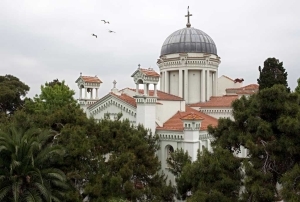 The Greek Orthodox church of Hagios Ioannis Prodromos, St. John the Baptist, is the most prominent monument in the village, its dome, raised on a high drum, dominating the view as seen from the ferry as one approaches the iskele. The church is a short way from the seafront on the first street to the south of the ferry landing.
The Greek Orthodox church of Hagios Ioannis Prodromos, St. John the Baptist, is the most prominent monument in the village, its dome, raised on a high drum, dominating the view as seen from the ferry as one approaches the iskele. The church is a short way from the seafront on the first street to the south of the ferry landing.
The present church, built in 1899, is believed to stand on the site of the katholikon of the Byzantine monastery of St. John. The original katholikon was probably built in the eleventh century, and parts of its structure are thought to be incorporated in the present church, which seems to retain the plan of the earlier structure. The evidence for this conclusion is presented by George Mastoropoulos in his Patriarchal Monasteries of the Princes’ Islands.
On the left side of the narthex, or vestibule, a stairway leads down to a small subterranean crypt with a vaulted ceiling. The crypt is dedicated to St. Methodios, for this is believed to be the dungeon in which he was imprisoned by Michael II, and where he remained for seven years before being released by the emperor Theophilos. Grosvenor describes the ordeal that Methodius endured before going to his final rest:
At Antigone, Theodora erected the Church of St. John the Baptist over the cave where the Confessor had been so long confined. In the renovated modern wooden [actually stone and brick] church, still the chief sanctuary of the islanders, little remains of the early edifice. Nevertheless the apse, or eastern portion, is part of the original structure.
Kınalıada
- Details
- Created on 18 February 2013
- Last Updated on 11 April 2013
Village Center
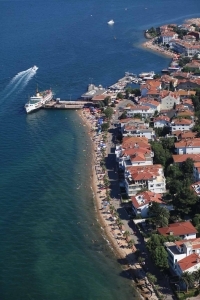 The focal point of the village, here as in the other three major isles, is the vapur iskelesi, or ferry landing, on the northeast shore. The new iskele for the sea bus is just beside the pier for the regular ferry on its south side.
The focal point of the village, here as in the other three major isles, is the vapur iskelesi, or ferry landing, on the northeast shore. The new iskele for the sea bus is just beside the pier for the regular ferry on its south side.
Kınalıada is the only one of the four larger isles that does not have faytons (horse carriages), and so those who want to explore the uninhabited western side of the island must do so on foot or by bicycle. Local residents claim to prefer the absence of horses which renders the island more sweet-smelling than its sisters. In any case, the island is so small that any destination can be reached within a few minutes’ walk.
The Greek Orthodox Church
The Greek Orthodox church is on Çınarlı Köşk Sokağı, a short way in from the shore road. The church is dedicated to the Genissa Panagia Theotokou, the Birth of the All Holy Mother of God, and was founded in 1886. The church is in the form of a three-aisled basilica with a narthex, entered from a courtyard-garden to its south. In the narthex there is a silver-clad icon depicting the Birth of the Virgin. There are other silver-clad icons on the iconostasis, or icon screen, which separates the nave from the sanctuary. The church celebrates the panigiri, or feast-day, of the Virgin’s birth on 7-8 October.
Surp Krikor Lusavoriç, Armenian Gregorian Church
 The Armenian Gregorian church is on Narçiçeğı Sokağı, on the third block in from the shore road. This was the first and only Armenian Gregorian church built on the islands. The church was founded in 1857 and is dedicated to Surp Krikor Lusavoriç, St. Gregory the Illuminator. The present church is the result of a complete reconstruction in 1988.
The Armenian Gregorian church is on Narçiçeğı Sokağı, on the third block in from the shore road. This was the first and only Armenian Gregorian church built on the islands. The church was founded in 1857 and is dedicated to Surp Krikor Lusavoriç, St. Gregory the Illuminator. The present church is the result of a complete reconstruction in 1988.
The altar curtain was taken from the Armenian church of St. Auxent in Trabzon. Behind the altar there is a painting of the Virgin and Christ Child. The altar is flanked by two paintings, the one on the left depicting St. Gregory the Illuminator, founder of the Armenian Gregorian Church, while the one on the right shows St. Nerses, patriarch of the Gregorian Armenian Church in the mid-fourth century. The side altar on the right is dedicated to St. Gregory, who is shown holding a model of the cathedral that he built at Etchmiadzin in Armenia. On the side walls of the nave there are panels containing attractive stone carvings in the medieval Armenian style. One of the panels commemorates the great Armenian composer Gomidas, who had a summer home on Kınalı during the years 1909-13.
Kınalıada Mosque
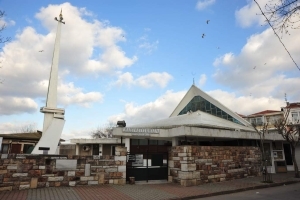 The Muslim community worships in Kınalıada Camii, which stands on the shore south of the iskele. The mosque was built in 1956 by the architect Başar Acarlı in a modern abstract style.
The Muslim community worships in Kınalıada Camii, which stands on the shore south of the iskele. The mosque was built in 1956 by the architect Başar Acarlı in a modern abstract style.
Monastery of the Transfiguration
 The present monastery of the Transfiguration is near the peak of Manastir Tepesi. This was built on the site of the Byzantine monastery of the same name, of which a number of architectural fragments have been built into the katholikon, or monastic church, while others lie scattered around the grounds. After the Turkish Conquest the monastery began to fall into ruins, but in 1722 a group of wealthy Greek merchants from Chios, who were doing business in Istanbul, financed a major restoration, building a new church on the site of the Byzantine katholikon and adding a side chapel dedicated to St. Paraskevi. The iconostasis and episcopal throne are in finely carved wood. The Byzantine icons from the original katholikon are preserved in the Greek Orthodox Patriarchate in Istanbul. The icons on the iconostasis of the present church are Russian works sent in 1723 to the patriarch Jeremias III from Tsar Peter the Great.
The present monastery of the Transfiguration is near the peak of Manastir Tepesi. This was built on the site of the Byzantine monastery of the same name, of which a number of architectural fragments have been built into the katholikon, or monastic church, while others lie scattered around the grounds. After the Turkish Conquest the monastery began to fall into ruins, but in 1722 a group of wealthy Greek merchants from Chios, who were doing business in Istanbul, financed a major restoration, building a new church on the site of the Byzantine katholikon and adding a side chapel dedicated to St. Paraskevi. The iconostasis and episcopal throne are in finely carved wood. The Byzantine icons from the original katholikon are preserved in the Greek Orthodox Patriarchate in Istanbul. The icons on the iconostasis of the present church are Russian works sent in 1723 to the patriarch Jeremias III from Tsar Peter the Great.
Sedefadası - Antirovithos
- Details
- Created on 18 February 2013
- Last Updated on 13 May 2013
Monastery
St. Ignatius founded a monastery for men on Antirovithos, in the mid-ninth century, one of three monatic esablishments he built on the Princes' Isles, all of which are mentioned in the list made by Manuel I Comnenus in 1158. The monastery on Antirovithos was rrestored in 1180 by the patriarch theodosius Boradiotis. All that remains of the monastery today is a fragmentary ruin on the northwestern promontory of the island.



